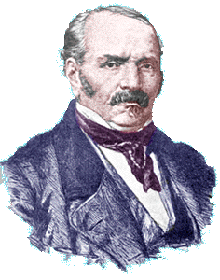Rivail
Becomes Allan Kardec & Publishes the Basic Works of Spiritism
On April 30th, 1856, a medium in Rivail’s study group, received,
from the spirits, the first indications of his mission. His
spirit guide, Zefiro, revealed to him the task
that lay ahead, i.e., that Rivail would publish a book with the teachings and
revelations given by the spirits, that the book would be titled Le Livre des
Espirits (The Spirits’ Book), and that he would publish it
under the pen name of Allan Kardec, a name that he was told he used in a
previous existence when he was a druidic priest, living in the town of Gail,
where Zefiro also resided.
|
Rivail himself said
that with that revelation, the meetings at the Brudins’ home, as well as the
collections of messages sent to him, began to take on a new
meaning and purpose. He said, “I
proposed, therefore, to resolve the problems in philosophy, psychology, and the
nature of the invisible world that interested me. I
arrived at each session with a series of questions prepared and methodically
proposed; they were answered in a logical manner, with precision and depth. From that moment, the
meetings began to have a very different character, and some of the attendees were
serious people who took a lively interest in the work.
If I happened to be absent from a session,
the excitement was dampened; futile questions had lost their charm for the
majority of attendees. At the
beginning, I had in mind only my own task.
Later, when I saw that everything formed a whole and took on the
proportion of a doctrine, I decided to publish the proceedings of the meetings
for everyone’s edification. When
the results were developed and completed, they formed the basis of The Spirits’
Book."
The
Spirits’ Book was completed in 1857, after Rivail studied additional
messages from more than ten mediums for outside confirmation of the
communications already received, as well as answers to some issues that he felt
required further explanation.
|
|

 |
The book was
very successful from its initial publication.
In 1858,
Rivail published a second edition with revisions, corrections, and
additions. In the same year, he
founded “The Parisian Society for Spiritist Studies” and began publication of
the monthly journal called Revue Spirite.
Following the
publication of the Spirits’ Book, Rivail
spent the remaining years of his life completing the codification of Spiritism
and disseminating its teachings. He spread the word through many lectures
on Spiritism and its philosophy, making several exhaustive journeys, at his own
expense, to take the teachings to as many people as possible. Over the course of the next 10 years, he published The
Medium’s Book, The Gospel as Explained by the Spiritist Doctrine,
Heaven and Hell, and Genesis, completing the codification of the
Spiritist body of work.
Kardec’s wife would later help to release Posthumous Works, an additional
collection of Kardec’s work, yet unpublished at the time of his death.

Throughout the
course of the years in which Kardec dedicated himself to Spiritism, he underwent
much suffering in the hands of his opponents, including the Church and Church
supporters, as well as others acting independently, who subjected him to acts of
mockery, criticism, ridiculous accusations, hate, jealousy, and ingratitude,
even, in some cases, from individuals he had trusted.
In 1861, during the Spanish Inquisition, the Bishop ordered the burning
of 300 Spiritist books, despite Kardec’s protest.
The constant struggle and amount of work involved left him fatigued and
took a toll on his health. But this was all foreseen, for even before the
publication of the Spirits’ Book, Kardec was warned by the spirits that he would
confront all these struggles. These warnings were all true, as confirmed
by Kardec himself in an essay he wrote ten years later.
During this time, he knew no peace, but he never gave up because he
strongly believed in the seriousness and importance of his work, and he kept his
faith in God, as well as in the spirits that guided and assisted him.
The time for
Kardec’s passage to the Spiritual World came in 1869.
Duncan writes, “On March 31st, 1869, having just finished
drawing up the constitution and rules of a new society that he planned to form,
while seated in his usual chair at his study-table in the Rue Sainte Anne, in
the act of tying up a bundle of papers, his busy life was suddenly brought to an
end. The passing from Earth into
the Spiritual World was instantaneous, a peaceful falling asleep - a fitting end
to a life well-lived. But although
the physical man is no longer with us, he lives on in Spirit, continuing his
work by inspiring, stimulating and encouraging us to continue our search for
knowledge.”

Kardec, Allan.
Christian Spiritism (a compilation of two Kardec books: " Spiritism Reduced
to Its Simplest Expression" and "What is Spiritism"). Trans.
Allan Kardec Educational Society (translated from original French editions,
published 1860 and 1859, respectively). Philadelphia, PA. Allan Kardec
Educational Society. 1985. 189-198.
Kardec, Allan.
"Translator's Preface." The Gospel Explained By The Spiritist Doctrine.
Trans. Janet Duncan (translated from 3rd edition in French). Essex, England.
Allan Kardec Publishing Limited. 1993. IX-XII.
Barbosa, Pedro
Franco. "Primordios do Espiritismo." [Origins of Spiritism] Espiritismo
Basico [Basic Spiritism]. 3rd ed. Rio de Janeiro-RJ, Brazil: Federação
Espírita Brasileira [Brazilian Spiritist Federation]. 1987. 49-58.
Kardec, Allan.
"Chapter Title" Obras Póstumas [Posthumous Works]. 8th ed. Trans.
Salvador Gentile. Ed (of translation). Elias Barbosa. (translated from 6th
edition in French). Araras-SP, Brazil. Instituto de Difusão Espírita [Institute
for Spiritist Dissemination].1993. 256-262.
Brochure,
"Welcome To Spiritism". Kardecian Spiritist Federation of Florida.


